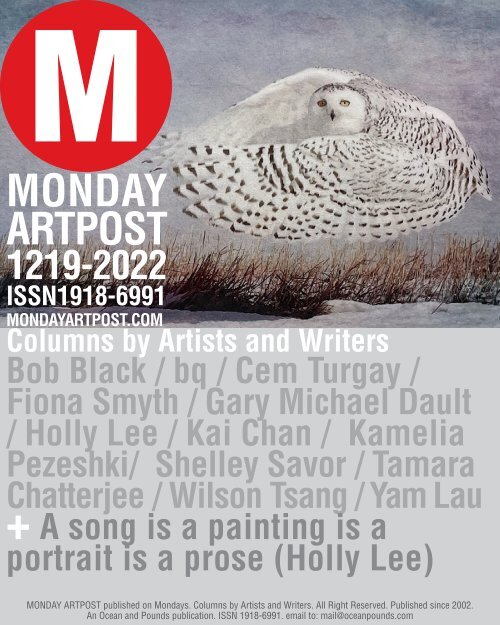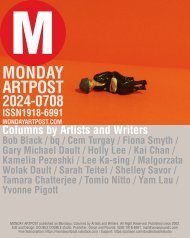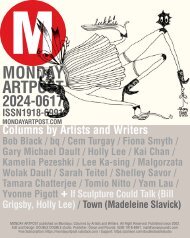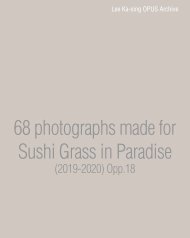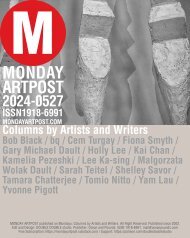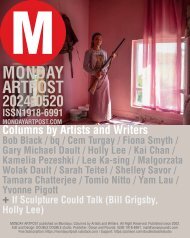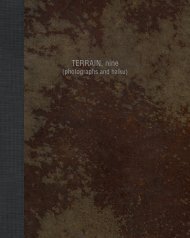You also want an ePaper? Increase the reach of your titles
YUMPU automatically turns print PDFs into web optimized ePapers that Google loves.
<strong>MONDAY</strong><br />
<strong>ARTPOST</strong><br />
<strong>1219</strong>-<strong>2022</strong><br />
ISSN1918-6991<br />
<strong>MONDAY</strong><strong>ARTPOST</strong>.COM<br />
Columns by Artists and Writers<br />
Bob Black / bq / Cem Turgay /<br />
Fiona Smyth / Gary Michael Dault<br />
/ Holly Lee / Kai Chan / Kamelia<br />
Pezeshki/ Shelley Savor / Tamara<br />
Chatterjee / Wilson Tsang / Yam Lau<br />
+ A song is a painting is a<br />
portrait is a prose (Holly Lee)<br />
<strong>MONDAY</strong> <strong>ARTPOST</strong> published on Mondays. Columns by Artists and Writers. All Right Reserved. Published since 2002.<br />
An Ocean and Pounds publication. ISSN 1918-6991. email to: mail@oceanpounds.com
Greenwood<br />
Kai Chan<br />
Study<br />
paper, wire
Poem a Week<br />
Gary Michael Dault<br />
Painters I like<br />
I like a painter<br />
whose fists<br />
beat on the canvas<br />
who cuts pigment<br />
into slices<br />
with a thumbnail<br />
whose boots<br />
are blackened with ink<br />
who gets painted<br />
into the spidery corners<br />
of studio time<br />
I like painters<br />
perpetually seated in moonlight<br />
always tyrannizing<br />
their freshly laid eyes<br />
I like painters<br />
who refuse all help<br />
who will piss<br />
on a candle flame<br />
give me a painter<br />
who meanders like a thread<br />
beneath the creaking<br />
of the crepuscular sun
ART LOGBOOK<br />
Holly Lee<br />
Michael Heizer’s City<br />
1. A city in the ocean of time<br />
https://gagosian.com/quarterly/<strong>2022</strong>/08/16/essay-a-city-in-the-ocean-of-time/<br />
2. After 50 years, Michael Heizer has finished his “City” in the desert<br />
https://www.collater.al/en/michael-heizer-city-desert-nevada-design/<br />
3. A mammoth artwork is born: Michael Heizer’s City opens in brutal Nevada desert after 50 years<br />
https://www.theguardian.com/artanddesign/<strong>2022</strong>/aug/28/mammoth-artwork-michael-heizer-citynevada-desert<br />
4. ATTEMPTING TO SKATE MICHAEL HEIZER’S MEGA SCULPTURE IN THE DESERT (video 6:39)<br />
https://www.jenkemmag.com/home/<strong>2022</strong>/09/21/attempting-to-skate-michael-heizers-megasculpture-in-the-desert/<br />
5. Archived news story from KSL.com: Huge, top-secret sculpture taking shape in desert (video<br />
4:41)<br />
https://www.ksl.com/article/32203469/huge-top-secret-sculpture-taking-shape-in-desert<br />
6. What Do Native Artists Think of Michael Heizer’s New Land Art Work?<br />
https://hyperallergic.com/763203/what-do-native-artists-think-of-michael-heizers-new-land-artwork/
… 談 笑 間 …<br />
Yam Lau
Leaving Taichung<br />
Station<br />
Bob Black<br />
The Cemetery for the Companionless<br />
“You can call me a thief if you like, a thief of ceremonies”--Fleur Jaeggy<br />
red lanterns sway upon the hip of night in guard of landlords who proffer unease and damp lungs<br />
in search of firefly and candle and those who might be, forever her, hungry in the alley sway--<br />
pictured and scampering and aflight,<br />
you dug in and dug upon the bone rags of the city, crepuscular and carnal from lost peace<br />
even-tiding the long lampposts, the barking pull of the food market stall for single evenings,<br />
wet bones twig and stretch from window’s scratch, branches just so,<br />
the twilight calligraphy kneels down next us and softens the soil, green with cadaver and lunglost<br />
night,<br />
their voices adrift, your rowing twilight<br />
eddies and names a shoaded and spaded vein upon the hillside,<br />
our ocean bed looking over the forlorn & foretold place, the poles of winter precarious in their<br />
certainty<br />
is it some graveyard singing<br />
the chanting ocular and the disappearing gust along the rakes,<br />
the life here in the high-browse corner of the city, our life a pandemonium of rust<br />
the ghouls pandemic and the letters we marked red in the candlelight and our unsewed trust--<br />
recall when your mother struck you and the sun went unglued, undiscussed.<br />
now risen, the chaperoned evening unbuckles right, negotiated kettles of time and weeds upturned<br />
a listing of a future nest, alright:<br />
to rhyme the darkness with ringing, song and shell,<br />
to grattle and grass the rattle between an elbow and the oxbow of concordant you<br />
to rooftop the tarred city lights<br />
to unshovel the world a kettle of ghosts, swaying and singing up barley brick<br />
--the pail of all this going clanging against the cedar doors and slab block walls, rhyming the night<br />
blue.
a turn of the clock and a porter held a brass box, face lock<br />
oxidizing the stiff and the matter of the matrilineal<br />
a pocket compass ticking the sky calendar and the city longitudinal and longing: the dead babies<br />
the rambling cats in the dirt, the bottles tossed onto the sky, the secrets needled along the riverbank<br />
the cacophony of oblivion tapped out in the orchestra of your heart and cobblestone feet:<br />
there is no pronoun any longer shadowed by the lone tree<br />
there is no pronoun any longer unkeyed<br />
there is no pronoun any longer<br />
there is no pronoun<br />
there is no, any longer<br />
behind us brevity, dissolution, cheer her at last,<br />
the torn glove, the darkened skirt, the innervated boot and your verbs running release<br />
an interlocking, blurrish enumerated vocabulary and we poured,<br />
sinewy and artery and word puzzle,<br />
all of us, some of you and a clove of me, together untackled and wettened,<br />
poured out forever and into our some canine limitlessness--<br />
a cemetery for the companionless.<br />
yet their lives scribbled-up foam, a spew down from the body into a golem shaping<br />
this inconvenient world and the alchemy and the algebra and the clocks of Middle Asia<br />
our preternatural dipping and dampening, earth to worm and soil to ephemeral,<br />
the divesting and the marriage of all we know and would become, swarming our-ward<br />
you and I and all the rest, bedfellows and heaven’s crew, and ocean wrek<br />
the outbreak of us downing and coming alive long after our bones and sinews into the sable<br />
the indeterminate eternal sea.<br />
for: Holly and Ka-sing Lee
The Photograph<br />
coordinated by<br />
Kamelia Pezeshki<br />
Snowy Owl Hover, 2016 by Wendi Schneider<br />
pigment ink on vellum over white gold leaf from the ’States of Grace’ series
Open/Endedness<br />
bq 不 清<br />
話 到 嘴 邊<br />
TIP OF THE TONGUE<br />
那 唯 一 一 次 沒 有 變<br />
成 欠 缺 水 仙 花 的 蝴 蝶<br />
你 也 決 定 了 下 贏<br />
那 盤 海 戰 棋<br />
That only time you turned<br />
Into a butterfly without daffodils,<br />
You also decided to win<br />
That game of Battleship.<br />
那 一 刻 , 一 切 都 在 你 的<br />
腦 海 裡 發 生 , 然 後 落 到<br />
紙 上 , 以 X 和 O 呈 現 ⋯⋯<br />
一 大 堆 的 策 略<br />
It’s all happening in your head<br />
At that moment, then down<br />
On paper, with the X’s and O’s…<br />
All these strategies.<br />
現 在 來 談 談 你 的 型 態 :<br />
你 演 繹 臂 與 腿 的<br />
方 式 正 像 那 種 葉 子<br />
在 雨 中 懸 蕩 的 概 念 , 它<br />
Now let’s talk about your form:<br />
The way you articulate your arms<br />
And legs is like the very notion of<br />
Leaves dangling in the rain, which<br />
反 映 了 我 們 對 必 然 性 謹 慎 的<br />
寬 容 。 我 們 必 須 對 系 統<br />
進 行 欺 詐 , 先 供 之 許 多 的<br />
隱 喻 , 然 後 是 偽 科 學 的 數 據<br />
Reflects our tolerance carefully<br />
Toward certainty. We must cheat<br />
The system by feeding it with many<br />
Metaphors, then pseudoscientific data,<br />
就 像 我 為 自 己 解 說 這 個 夢 的<br />
方 式 。 它 涉 及 一 邊 捏 造 事 實<br />
一 邊 離 開 前 往 新 的 日 出 , 而 在 那<br />
一 個 新 的 字 詞 在 等 待<br />
Like the way I explain this dream<br />
To myself. It involves making stuff<br />
Up as you move on to a new sunrise where<br />
A new word awaits.
CHEEZ<br />
Fiona Smyth
From the Notebooks<br />
(2010-<strong>2022</strong>)<br />
Gary Michael Dault<br />
From the Notebooks, 2010-<strong>2022</strong><br />
Number 158: Still Life in Time of War (November 17, <strong>2022</strong>)
TANGENTS<br />
Wilson Tsang<br />
Giant Wing
ProTesT<br />
Cem Turgay
Caffeine Reveries<br />
Shelley Savor<br />
Festive Skating
Travelling Palm<br />
Snapshots<br />
Tamara Chatterjee<br />
France (March, <strong>2022</strong>) – Failure to validate<br />
our program vouchers meant a change in<br />
plan. Instead I wandered around enjoying<br />
the blooming season amid the renovated<br />
gardenscape surrounding Les Halles. I took<br />
my time taking in the modernized plaza and<br />
entry into the commercial centre, the vintage<br />
construction now replaced by a glass and<br />
metal canopy. The short interlude included<br />
gazing at an effervescent queue, attempting<br />
to discover their clone (Lego) figurine. ‘Twas<br />
amusing to observe the lively expressions,<br />
before taking off to rejoin the troupe.
Holly Lee<br />
A song is a painting is<br />
a portrait is a prose<br />
(an essay)<br />
89 • The Golden Lotus •<br />
Footsteps of June<br />
(selected photographs)<br />
An excerpt from DOUBLE DOUBLE November issue <strong>2022</strong>
A song is a painting is<br />
a portrait is a prose<br />
written by Holly Lee<br />
From Barber to Agee to Evans<br />
The first time I heard James Agee’s words were set to music, and sung by a soprano<br />
with a beautiful voice. I didn’t know him then, and gradually get to know him a little<br />
more. Not enough. Because of the music, the words and the poetry, I was driven to buy<br />
his book A Death in the Family.<br />
Agee’s rapturous prose-poem, Knoxville: Summer, 1915 was written in less than an<br />
hour and a half, and on his revision, stayed 98 percent faithful to the original writing.<br />
When I heard the music for the first time, I immediately fell for it. I was eager to<br />
know, who’s the composer, who’s the lyricist, who performed it. It was Samuel Barber,<br />
who set Agee’s Knoxville to music, and the version that I’d heard was sung by Renée<br />
Fleming. Obviously, my knowledge in contemporary classical music is as limited as my<br />
proficiency in 20th Century literature. But that doesn’t matter, I’ve become infatuated<br />
by both composer and writer since.
Described as “lyric rhapsody” by Barber, he used about 1/3 of the prose-poem for<br />
the score, conjuring up a 16-minute dramatic song for soprano and orchestra. There<br />
is a universality of idyllic, nostalgic beauty in the work, that even for a person from<br />
the Far East could grasp and resonate. The shortened prose set in lines was already<br />
very impressive, but reading the original prose; I was enraptured with the free flow of<br />
language, the meticulous observation of everyday life in amplified details, sentences<br />
filled with humanity and purity of the heart.<br />
On the bookshelf there is an old book I bought in the late eighties, which I rarely<br />
touch, and remember only its approximate contents. It was about the Farm Security<br />
Administration project; about some photographs taken by Walker Evans and text<br />
written by James Agee—a documentation of the lives of three impoverished tenant<br />
farmers during America’s Great Depression. I bring this up because, after some twenty<br />
years, I finally picked up Walker Evans’s 650 pages biography and start reading. It<br />
was from this point I remember the book “Let Us Now Praise Famous Men”, the book<br />
I mentioned above. The book, with its photographs and text, left the world an indelible<br />
impression on the poverty-stricken American South in the 30s. In it, I found a written<br />
account of Agee by Evans. I was struck by its vividness and unconventional style of<br />
writing, full of wit, beaming with life and personality. It is a “written” portrait of James<br />
Agee. Walker Evans is not only a great photographer, he is unequivocally a brilliant<br />
writer.<br />
I could have ignored, and kept ignoring Agee’s prose and poetry, and Evans’s<br />
photography, had I not been touched incidentally by Barber’s Knoxville. Music leads<br />
to words, and words lead to imagery, which brings me back to writing. As I learn more<br />
about Barber’s music, I’m impacted by his Adagio for Strings, which I have heard<br />
before, but not knowing: it is one of the saddest compositions in contemporary classical<br />
music.<br />
The Original Sisters to The Golden Lotus<br />
Anita Kunz acknowledged women of significance, known or unknown, with her brush<br />
strokes. Recently she has created a substantial body of work, bringing illustrious<br />
females front and centre to the printed page, naming the book “Original Sisters”.<br />
Drawing one portrait a day, the two year lockdown period gave her plenty of quiet<br />
time to focus on this project. Most characters in the series are long gone, and some<br />
she was only made aware of from her friends. The way she portrayed the figures relied<br />
mainly on public sources, and images she found on the Internet—very generic, and<br />
generalized. With her experience and well-versed skill, she deftly picked up heat and<br />
intensity of the individuals, modified and idealized with her personal touch.<br />
In the portrait of Anna Akhmatova, she set her against a red background, her sharp<br />
profile characterized by the nasal bump, and a fringe. Her hair is tied back into a<br />
soft bun, a red bead necklace hung down her shoulders stressing their roundness by<br />
the low-cut V-shaped dress. One can almost hear Akhmatova’s line: you will hear<br />
thunder and remember me, and think: she wanted storms. Camille Claudel is another<br />
beguiling portrait. The overall tone of the painting clings to an earthly brown. Her head<br />
and shoulders are elongated; her hair unkempt, raining down in rings of frenzy; her<br />
face is like porcelain, cracked and broken like her mental state, her intelligence and<br />
virtuosity are reflected by the delicately painted French embroidered lace. After almost<br />
close to a century, Camille Claudel’s sculptures are widely accepted, and proclaimed<br />
as great as Rodin’s—her once teacher, mentor, and lover.<br />
As Kunz celebrates the achievement of distinguished women in pictures, I contemplate<br />
on the submissive roles Chinese women have endured over the centuries, ever more<br />
feeling the privilege of living in a better, freer world of gender and racial equality. In<br />
1989, I was invited to work on a multi-platform art project, which had incorporated<br />
dance, performance, drama, music and photography. It was based loosely on the<br />
Chinese classical novel: The Golden Lotus. The novel took place in the 12th century,<br />
and encompassed many female characters, which made me think about the three-inch<br />
golden lotus—the synonym for the bound feet of women. I proposed to take a suite<br />
of portraits of the artists. Not deliberately, but out of subconsciousness, many of the<br />
portraits I took possessed strong gestural bearings of the hands and feet.<br />
When I was asked to participate in The Golden Lotus Project, the Tiananmen Square<br />
protests had just started in China. My approach to the portrait series of the performers<br />
and musicians was not meant to be direct interpretation of the characters in the book,<br />
and the six weeks of protests in China ending in bloodshed perturbed me immensely. It<br />
reflected clearly in my portrait of the musician Peter Suart. Suart, a young English lad<br />
born in Hong Kong, was in Beijing during the incident. He was a first-hand witness
ut left the capital before the brutal crack down. We worked together on the idea of<br />
the shot. In the shooting session, he wore the leather trench coat he bought in Beijing,<br />
grabbing two spiky Indonesian musical instruments acting as sharp claws; he spread<br />
his wings and soared like an eagle. The background was an old poem, composed and<br />
made into woodcut by Ka-sing. The poem was about free will, and choice. Tea or<br />
coffee. My title of the work echoed these thoughts. It came to be: 89 • The Golden<br />
Lotus • Footsteps of June (1989) 八 九 • 金 瓶 梅 • 六 月 前 後 .<br />
taking off my wartime garments. I’m putting on my old time wear. Gently, gently, I’m<br />
releasing and combing my long-tangled hair. Before the mirror I stare, ornamenting my<br />
brow with gold floral print cut in pairs. Stepping outside, I’m calling to my comrades.<br />
Shocked and startled, not even my confidant recognizes me! Oh, my companions<br />
for twelve long years. Listen to me, and look. Some distance away, among the thick<br />
bushes, a male rabbit scurried north; a female rabbit looked vague and lost. Both<br />
running, dear mates, are you able to tell if this one a buck, or that one a doe?”<br />
Buck or Doe: The Ballad of Mulan 木 蘭 辭 , a re-imagination<br />
She became a warrior by necessity, at a time when well water could not be mixed with<br />
river water. She was that quiet water knitting from dawn to dusk; her sole music came<br />
from her own breathing; her loom click click and click click.<br />
A troubled, unrest heart. How was her old father to fight? The Khan was merciless;<br />
soldiers were just numbers, recruited fast and perished fast. She would take up the<br />
duty, cut her hair, bind her breasts, wear her boots, and head to the market. East to get<br />
a fine stead; west, a saddle; south, a bridle, and north a long whip. Farewell farewell<br />
my parents. By dusk I’d be resting by the Yellow River, another dusk on the black<br />
mountains of Mongolia. Your calling became so feeble, I couldn’t bear to hear.<br />
Ten thousand miles she rode and battled, swept through fields and mountain passes.<br />
The north wind blew, the gong hit at midnight. Her armour shimmered under cold,<br />
silvery light. For ten years she fought on countless battlefields, battered bodies laid<br />
bare, and unsettled. For ten years, she combated and survived, returned gloriously,<br />
kneeling to meet her emperor. On his high throne he offered her praise, high rank, and<br />
gold. All these to her, were moon in the water, flower in the mirror. All she asked for<br />
was a good horse, accompanying her in her toilsome journey, speeding her safely back<br />
to her village; back to home, sweet home.<br />
Postscript<br />
In our age, most people associate Mulan as a Disney cartoon character of Asian origin,<br />
a woman disguised as a man going to battle for his aging father. Mulan is a fictional<br />
folk heroine from China’s Northern dynasties (Northern Wei, 386-534 AD), a time<br />
when many famous Buddhist rock-cut cave temples were constructed at Yungang<br />
and Longmen. Mulan is believed to be of Chinese/Xianbei ancestry (no bound feet!).<br />
Mulan is perhaps even a tribal name, leaving the highly regarded heroine, like<br />
many others, anonymous. But her brave deeds have survived and inspired people for<br />
many centuries. The Ballad of Mulan is collected from oral traditions, transcribed<br />
into written language, as a beautiful rhymed song. Though there are many English<br />
translations of this ballad available on the Internet, I have the urge to re-imagining the<br />
scene, and re-writing it in a prose form.<br />
Her news of returning reached home faster than her feet. Her father, mother walked<br />
out of the city arm-in arm. Her neighbours all came out to greet. Her sister rouged her<br />
cheeks in rosy red; her brother whetted his knife for pigs and sheep.<br />
Entering from east chamber door, settling on west chamber bed, she sings, “I’m
Mui Cheuk Yin 梅 卓 燕<br />
performer
Peter Suart 彼 得 小 話<br />
musician
Kung Chi Shing 龔 志 成 , Peter Suart 彼 得 小 話<br />
musicians
Under the management of Ocean and Pounds<br />
Since 2008, INDEXG B&B have served curators, artists,<br />
art-admirers, collectors and professionals from different<br />
cities visiting and working in Toronto.<br />
INDEXG B&B<br />
48 Gladstone Avenue, Toronto<br />
Booking:<br />
mail@indexgbb.com<br />
416.535.6957


